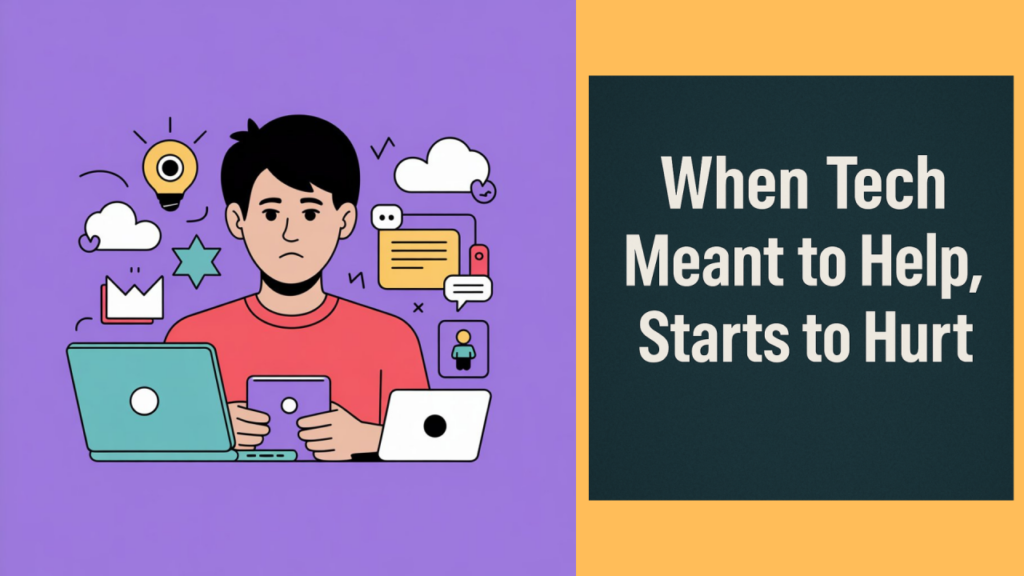In the age of endless Zoom meetings, pinging inboxes, and AI dashboards, technology was meant to be our productivity partner. But for many corporate professionals, it has silently morphed into a 24/7 surveillance partner — always on, always watching, always expecting.
The result? A digital drain that doesn’t just eat into your time — it erodes your mental clarity, emotional calm, and creative edge.
The Rise of Technostress Share on XTechnostress is not a passing phase — it’s a psychological reality. A McKinsey report in 2024 confirmed this:
“Employees overwhelmed by workplace technology are 23% more likely to experience burnout and emotional fatigue.”
Add to this the unspoken expectation to be available beyond office hours, and you’ve got the perfect recipe for long-term mental exhaustion.
🕐 Always On, Always Anxious
Most professionals today aren’t just working — they’re hyper-working:
- Answering emails at midnight
- Managing five tools just to keep one task moving
- Never feeling truly “logged off”
This continuous cognitive load doesn’t just hurt productivity — it chips away at your peace of mind, one notification at a time.
🛠️ What Companies Should Do
In an ideal world, organizations would:
- Audit their tech stacks regularly
- Normalize digital downtime
- Train managers in digital empathy
- Respect personal boundaries beyond work hours
And many progressive organizations do. But here’s the hard truth — many don’t. And even when employees raise their voices, those concerns are often unheard, unacknowledged, or unfollowed.
❗What If HR Doesn’t Listen?
Let’s talk about the elephant in the meeting room.
You speak up. You raise your discomfort. You suggest better practices. But all you get is a polite nod and a policy that collects dust.
This is more common than we’d like to admit — especially in rigid hierarchies or profit-centric environments.
So what do you do then?
You turn inward, not in silence, but in self-preservation.
🙋♂️ What Employees Can Do — Even When No One Else Will
Sometimes, the system won’t shift — but you can still protect your sanity. Here’s how:
- Create Personal Tech Boundaries Use “Focus Mode,” “Quiet Hours,” and time-blocking on your calendar. Even if the company doesn’t formalize it, you can still claim your zone.
- Communicate Clearly, Not Just Loudly Instead of venting, document patterns — how tech overload affects delivery, wellness, or team collaboration. Evidence invites action more than emotion alone.
- Use Tech to Tame Tech Leverage digital well-being tools like:
These aren’t gimmicks — they help create intentional digital boundaries.
- Practice Controlled Disengagement You’re not a machine. Choose one non-negotiable switch-off time every day. Reclaiming even one hour consistently is a revolution in disguise.
- Build Your Micro-Community Connect with colleagues who feel the same. Sometimes, a collective voice gets noticed more than individual whispers.
- Plan Your Exit Strategy (if needed) If mental wellness is consistently dismissed, it’s a sign — not of your weakness, but the workplace’s unwillingness to evolve. You owe your loyalty to your life first.
💡 Final Thought
You can’t always control how your organization responds. But you can always choose how you protect your peace.
Mental wellness in the digital age isn’t just a benefit — it’s a battle for your bandwidth. And every time you say no to digital overwhelm, you say yes to your inner clarity.
Stay aware. Stay anchored. Stay human.
Because the real “upgrade” is not in our tools — it’s in our relationship with them.
If you’re feeling overwhelmed by technology or struggling with stress in your professional life, it’s time to take action. Let’s work together to create a personalized strategy for boosting your resilience, improving your work-life balance, and reclaiming your peace of mind.
Book a free consultation today, and let’s start your journey toward a healthier, more productive work life.

